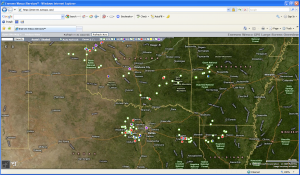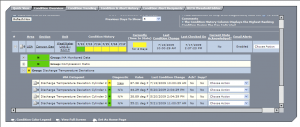June 2010 Vol. 237 No. 6
Features
Reduce Compressor Maintenance Costs With Remote Monitoring
Remotely located gas compressors can pose a significant operating and maintenance challenge. Supervisory control and data acquisition (SCADA) systems are often used to address this challenge, but to be cost effective, a critical mass of units must be located in close proximity to one another.
Additionally, traditional SCADA systems have limited analytical capabilities. The result is that a tremendous amount of data is produced, but the utility of the data can be marginal.
Internet-based monitoring can help overcome these challenges by providing the ability to monitor individual remote assets and by providing tools to make the data operationally relevant to the organization. One area where remote monitoring can have significant benefits is within an organization’s maintenance program, but there are many others including dispatch, machinery analysis, and diagnostics.
In order to maximize the benefit received from deploying a monitoring system, the culture of the organization must be ready to take advantage of the software. It is critical that business personnel are comfortable with the investment and the return on the investment. A company’s operational staff needs to understand how the system will benefit them in their day-to-day activities. Everyone who interacts with the system must be fully trained and engaged with the program. Success with remote monitoring requires the full commitment of the entire organization.
Set Up
Due to the remote nature of leased compressor deployment, most setups benefit from utilizing satellite communications. Cellular communication systems work for some of these units, especially those at compressor stations since they are unlikely to move. However, for leased units that are likely to move over time, satellite communications systems ensure that the units will always be able to communicate.
A piece of hardware in the field communicates with the control panel to gather pertinent information. The units can transmit once a week, once a day, once an hour, or more frequently depending upon how the data will be used. Additionally, the device reports whenever a shutdown occurs. The device handles two-way communications and ensures that every message is acknowledged automatically as it is received by the data center. This capability allows the unit to be shut down remotely in the event that the equipment is running in a manner that could damage the unit.
To fit each field unit generally requires an average of less than six hours on site. If an upgrade is necessary – such as adding a panel annunciator, instrumentation, or correcting grounding issues -it can add two to six hours to the project. Figure 1 shows what a typical installation might look like. The enclosure contains the remote monitoring equipment and the satellite communications terminal is mounted on the top of a pole.
Remote monitoring systems assume that proper instrumentation is already in place and takes advantage of data that are usually already being collected at the panel. The remote monitoring device then connects to the panel utilizing Modbus RTU or similar protocols.
The most important data points to monitor when it comes to maintenance scheduling are run-hours. Typically, this can be derived from a digital input from the oil pressure switch and has been found to be more reliable than run hour meters on various control panels. Other applications may require additional data points to be enabled. For example, if you are given a high discharge temperature, which indicates a potential valve problem, this vital information is important to have at the time of dispatch, it ensures that the technician has the parts required to address the problem. If you are interested in doing machinery analysis it is likely that you will want to monitor suction temperature by stage in order to be able the run diagnostic algorithms.
Run Hours
Most maintenance schedules are based on the estimated number of hours the unit is running. However, most maintenance programs that are utilized in the industry use calendar projections to determine when maintenance should be performed. This method tends to overestimate equipment usage, causing maintenance to be performed more frequently than necessary.
Remote monitoring takes all of the guesswork out of the equation. Operators know the exact runtime of their equipment allowing maintenance schedules to be optimized.

Figure 2: This screen capture image shows the maintenance view in the hosted software. It lists a number of maintenance procedures and when they are due for a single unit. Projections are calculated based on runtime for the unit. Red indicates maintenance that is overdue. Clicking on the view detail button allows the operator to see the specifics associated with the maintenance code.
Status At A Glance
All of an organization’s assets can be viewed simply by looking at a single digital map. If a unit is operating outside of normal parameters, the color of its symbol changes on the map. This allows managers to efficiently allocate resources with the right skills to do the job. If an asset requires a call out, if maintenance is due, it can also be scheduled and performed, reducing the need for an additional callout. This results in a reduced number of trips to each unit, which in turn results in a significant cost savings.

Figure 3: The map gives users a fleet-wide view. A red dot indicates a unit that is down.
Doing More With Less
Whether gas prices are low or high, utilizing remote monitoring as the basis of a maintenance program makes sense. Today’s market conditions necessitate that the industry do more with less. Automation, including the automation of maintenance programs helps organizations get more out of their limited resources. One of the keys to success is to identify areas where automation can have a real impact on the operating performance of the organization.
Maintenance is often overlooked when it comes to automation. However, real-world customer experience clearly demonstrates information that utilizing remote monitoring as a component of one’s maintenance programs can result in significant cost savings. Whatever the market conditions, efficiency is the most important component of all.
Plan For Expansion
It is important to start with the basics but plan ahead for long-term objectives in remote monitoring. Adding in additional features is fairly easy to accomplish if you have planned ahead and started with a system that will grow.
In the case study presented, the initial system was designed so it could be expanded to increase data points, calculations of approximated HP loads, onsite/online oil condition monitoring, remote shutdown and even simple control loop functions. When considering flexibility it is important to consider both the hardware and software components.
The larger and more robust the system the more you can do in the future to accomplish different goals. A larger system is capable of numerous I/O data points, control loop functions, onsite internet access, WiFi enabled, remote starting, data tapping or bringing back additional data such as EFM, tank levels and many other expandable features.
Additional service options are also available. These include remote diagnostics and machinery analysis, dispatch and safety applications (Figure 4).

Figure 4: The screen shot shows what a machinery analysis and diagnostic application looks like. Yellow indicates a minor issue. Clicking on “view” will provide a diagnosis of what’s causing the condition change.
The equipment used to collect this data may be the same as that used for preventive maintenance applications. However, the way the data is utilized and analyzed is different. In this example the unit is in a yellow condition due to a discharge temperature deviation in Cylinder 2. The user can then drill down to see a diagnostic code that will indicate potential causes of the issue. In the scenario described, the system suggested that there was a probable valve or ring leak.
System Costs
There are various costs associated with deploying the system. These include the cost of the monitoring hardware, installation, communications and monthly service. The total initial investment is usually around $4,500 per unit and the ongoing monthly costs are $48 per unit. The payback period has been calculated to be 18 months based on a three-year commitment to the service. The same $4,500 piece of equipment may also be use to collect up to eight data points, but if more data is required, the maximum one should expect to pay, including installation, would not be more than $6,500. For the various monthly service options, prices generally start as low as $20/month for daily Global Positioning System (GPS) reports, to $400 a month for a complete package.
Conclusion
In order to receive the benefits of remote monitoring the organization must have a fundamental commitment to properly maintaining their equipment. Some organizations have made the decision to forgo maintenance as a component of their cost-cutting program. In this event, adding remote monitoring will have limited success.
Acknowledgement
This article is based on a presentation at the Gas Machinery Conference, Oct. 5-7, 2009, in Atlanta, GA.
Authors
Donald I. Wallace is president and CEO of M2M Data Corporation, Englewood, CO. He joined the company in 2002 as COO/VP of Engineering and Operations and was appointed to his present posts in 2004. During his 35-year career he has been responsible for the development, engineering, rollout and sales of complex systems for industrial automation and SCADA applications for major industrial and commercial companies including Xcel Energy, Williams Pipeline, Saudi Aramco, Amoco, Conoco and Chevron.
Robert W. Carter is vice president of Engineering and Technology for Enerven Compression Services LLC, Dallas, TX. He founded World Wide Energy Solutions Company (WESCO) which was sold to Enerven and he has held positions with other companies with titles such as Global Technology Development and Support, Vice President of Technical Services, International Project Manager, Country Manager and Service Center Manager. He has completed a variety of specialized training courses.





Comments